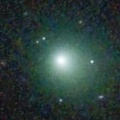
|
It brightened rapidly. Now it is very bright as 10.6 mag (May 12, Chris Wyatt). It stays observable at 11 mag in good condition for a long time from spring to summer.
Date(TT) R.A. (2000) Decl. Delta r Elong. m1 Best Time(A, h)
May 15 13 38.77 29 2.7 1.415 2.164 125 11.1 22:05 ( 0, 84)
May 22 13 36.79 26 49.7 1.422 2.140 122 11.1 21:36 ( 0, 82)
|
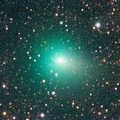
|
It brightened up to 8.9 mag in April (Apr. 12, Carlos Labordena). Now it is fading. But it is still bright as 10.1 mag (May 11, Carlos Labordena). It stays observable in excellent condition for a while. It will be fading after this, and it will fade down to 13 mag at the end of May.
Date(TT) R.A. (2000) Decl. Delta r Elong. m1 Best Time(A, h)
May 15 11 45.82 27 25.1 0.920 1.576 109 11.3 20:34 ( 34, 81)
May 22 11 22.06 24 43.3 1.148 1.656 99 12.1 20:42 ( 65, 69)
|

|
Now it is bright as 12.7 mag (May 9, Jose Guilherme de S. Aguiar). It stays bright as 11-12 mag until August. In the Southern Hemisphere, it stays observable in excellent condition for a long time. In the Northern Hemisphere, it stays observable in good condition for a while. But it becomes extremely low after July.
Date(TT) R.A. (2000) Decl. Delta r Elong. m1 Best Time(A, h)
May 15 20 24.56 -1 30.8 0.505 1.243 105 12.2 3:18 (323, 47)
May 22 20 52.21 -5 12.3 0.478 1.236 106 11.9 3:11 (324, 43)
|
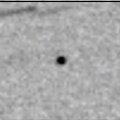
|
Now it is 11.2 mag (Apr. 19, Chris Wyatt). Appearing in the morning sky in the Southern Hemisphere. In the Northern Hemisphere, it will appear in the morning sky in June.
Date(TT) R.A. (2000) Decl. Delta r Elong. m1 Best Time(A, h)
May 15 1 2.95 -0 28.7 2.137 1.513 40 12.1 3:18 (268, -3)
May 22 1 22.02 0 55.4 2.135 1.540 42 12.2 3:11 (267, -2)
|
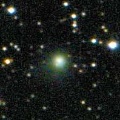
|
Now it is 12.8 mag (Apr. 27, Thomas Lehmann). It will brighten up to 10 mag in winter in 2022. In the Northern Hemisphere, it stays observable in good condition for a long time, although it becomes extremely low temporarily from May to June. In the Southern Hemisphere, it is not observable until November.
Date(TT) R.A. (2000) Decl. Delta r Elong. m1 Best Time(A, h)
May 15 3 43.59 50 33.2 4.981 4.158 31 12.7 20:34 (149, 8)
May 22 3 57.30 50 26.4 4.970 4.126 30 12.6 20:42 (151, 6)
|
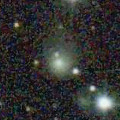
|
Now it is 13.5 mag (May 8, Sandor Szabo). It is expected to be observable at 5-6 mag for a long time from 2022 to 2023. In the Northern Hemisphere, it is not observable at the high light from 2022 summer to 2023 summer. In the Southern Hemisphere, it stays extremely low for a while. But it will be observable in good condition at the high light.
Date(TT) R.A. (2000) Decl. Delta r Elong. m1 Best Time(A, h)
May 15 18 13.55 42 56.7 5.996 6.371 107 12.9 2:43 (180, 82)
May 22 18 8.67 43 16.5 5.906 6.314 109 12.9 2:11 (180, 82)
|
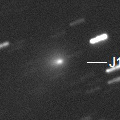
|
Now it is bright as 12.8 mag (May 9, Hirohisa Sato). It stays 13 mag until early summer. In the Southern Hemisphere, it stays observable in good condition for a long time. It is getting higher slowly also in the Northern Hemisphere.
Date(TT) R.A. (2000) Decl. Delta r Elong. m1 Best Time(A, h)
May 15 15 29.01 -29 54.4 2.367 3.364 168 13.0 0:01 ( 0, 25)
May 22 15 10.15 -27 21.9 2.374 3.370 167 13.0 23:08 ( 0, 28)
|
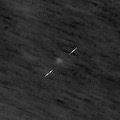
|
Now it is 14.5 mag (May 9, Ken-ichi Kadota). It will brighten up to 10 mag from summer to autumn, and it will be observable in excellent condition. Appearing in the morning sky.
Date(TT) R.A. (2000) Decl. Delta r Elong. m1 Best Time(A, h)
May 15 0 4.07 4 23.3 2.459 1.994 51 13.7 3:18 (273, 12)
May 22 0 19.83 5 51.7 2.371 1.956 54 13.5 3:11 (272, 13)
|
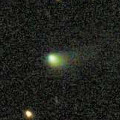
|
Now it is 14.5 mag (May 3, Ken-ichi Kadota). It stays 13-14 mag from 2020 to 2021. It will be observable in good condition after this in the Southern Hemisphere. It locates somewhat low in the Northern Hemisphere.
Date(TT) R.A. (2000) Decl. Delta r Elong. m1 Best Time(A, h)
May 15 19 29.55 -27 14.0 2.208 2.898 124 13.6 3:18 (350, 27)
May 22 19 30.20 -27 58.1 2.141 2.904 130 13.6 3:11 (355, 27)
|
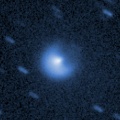
|
Now it is not observable. It will appear in the morning sky in July.
Date(TT) R.A. (2000) Decl. Delta r Elong. m1 Best Time(A, h)
May 15 3 31.65 27 1.8 6.878 5.880 8 14.0 20:34 (135,-11)
May 22 3 37.82 27 20.7 6.882 5.882 8 14.0 3:11 (226,-10)
|
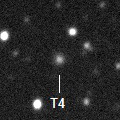
|
Now it is 14.5 mag (Apr. 30, Chris Wyatt). It is expected to brighten up to 11.5 mag in 2022. It is observable in excellent condition in the Southern Hemisphere. In the Northern Hemisphere, it is not observable until November.
Date(TT) R.A. (2000) Decl. Delta r Elong. m1 Best Time(A, h)
May 15 8 19.47 -27 18.0 5.305 5.304 84 14.2 20:34 ( 49, 8)
May 22 8 24.58 -26 27.7 5.345 5.271 80 14.1 20:42 ( 54, 3)
|
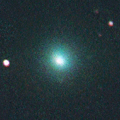
|
It brightened up to 10.5 mag in early March (Mar. 8, Bob King). Now it is fading. But it is still bright as 13.6 mag (Apr. 21, Ken-ichi Kadota). In the Northern Hemisphere, it stays observable in the evening low sky until early June while the comet will be fading. It is not observable in the Southern Hemisphere.
Date(TT) R.A. (2000) Decl. Delta r Elong. m1 Best Time(A, h)
May 15 5 48.33 32 23.2 2.301 1.575 34 14.3 20:34 (119, 15)
May 22 6 12.84 31 14.8 2.422 1.664 32 14.6 20:42 (120, 12)
|

|
Now it is very bright as 13.3 mag (May 10, Alan Hale). It will brighten very rapidly, and it will brighten up to 10 mag from July to August. It stays observable in the morning sky for a long time.
Date(TT) R.A. (2000) Decl. Delta r Elong. m1 Best Time(A, h)
May 15 23 14.04 -12 28.1 1.239 1.299 69 15.1 3:18 (294, 11)
May 22 23 43.67 -9 7.1 1.182 1.241 68 14.4 3:11 (290, 12)
|

|
It brightened up to 11.6 mag in winter (Feb. 18, Thomas Lehmann). Now it is fading. It has already faded down to 14.3 mag (Apr. 30, Chris Wyatt). In the Southern Hemisphere, it stays observable in good condition after this. In the Northern Hemisphere, it will never be observable after this.
Date(TT) R.A. (2000) Decl. Delta r Elong. m1 Best Time(A, h)
May 15 4 36.15 -55 6.8 2.744 2.674 75 14.4 20:34 ( 44,-41)
May 22 4 43.39 -54 4.5 2.816 2.737 75 14.6 20:42 ( 46,-45)
|
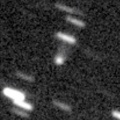
|
Now it is 14.9 mag (Apr. 19, Chris Wyatt). It was expected to brighten up to 13 mag from spring to summer. But actually, it is fainter than originally expected. It stays 14-15 mag until early autumn. In the Southern Hemisphere, it stays observable in good condition for a long time. In the Northern Hemisphere, it is not observable until July in 2022.
Date(TT) R.A. (2000) Decl. Delta r Elong. m1 Best Time(A, h)
May 15 21 1.84 -77 2.4 3.145 3.613 109 14.5 3:18 (352,-24)
May 22 21 23.52 -78 31.5 3.112 3.607 111 14.5 3:11 (353,-25)
|
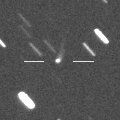
|
It will brighten up to 14.5 mag from spring to summer. In the Southern Hemisphere, it stays observable in excellent condition for a long time. In the Northern Hemisphere, it is not observable after this.
Date(TT) R.A. (2000) Decl. Delta r Elong. m1 Best Time(A, h)
May 15 1 33.46 -60 17.6 2.595 2.657 82 14.7 3:18 (323,-35)
May 22 2 6.36 -62 47.8 2.539 2.665 85 14.7 3:11 (326,-37)
|

|
Now it is 15.3 mag (May 8, Sandor Szabo). It will stay at 14-15 mag for a long time from 2021 to 2022. It stays observable in good condition after this while brightening gradually.
Date(TT) R.A. (2000) Decl. Delta r Elong. m1 Best Time(A, h)
May 15 17 56.40 -0 10.4 4.361 5.165 138 14.8 2:27 ( 0, 55)
May 22 17 49.63 -0 43.5 4.283 5.152 145 14.8 1:52 ( 0, 54)
|
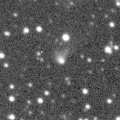
|
Now it is 15.3 mag (Apr. 19, Chris Wyatt). It stays 14-15 mag until the end of 2021. In the Southern Hemisphere, it stays observable in good condition for a long time. In the Northern Hemisphere, it is not observable until June.
Date(TT) R.A. (2000) Decl. Delta r Elong. m1 Best Time(A, h)
May 15 23 31.20 -36 21.7 4.438 4.347 78 14.9 3:18 (310, -7)
May 22 23 35.13 -35 52.8 4.356 4.353 83 14.9 3:11 (312, -4)
|
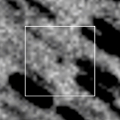
|
Now it is 17.5 mag (Apr. 20, J.-F. Soulier). Brightening very rapidly. It will brighten up to 8.5 mag from September to October. But the condition is bad in this apparition. In the Northern Hemisphere, it is observable only in the extremely low sky until July. In the Southern Hemisphere, it will be observable after late August. But it stays locating low for a while.
Date(TT) R.A. (2000) Decl. Delta r Elong. m1 Best Time(A, h)
May 15 2 22.86 45 24.0 2.612 1.805 29 15.4 3:18 (221, 10)
May 22 2 48.98 45 26.9 2.553 1.733 28 15.0 3:11 (220, 10)
|
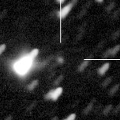
|
Now it is 15.6 mag (Apr. 12, Chris Wyatt). It stays 15 mag until summer. In the Southern Hemisphere, it stays observable in good condition until June. In the Northern Hemisphere, it is observable in the low sky from March to May.
Date(TT) R.A. (2000) Decl. Delta r Elong. m1 Best Time(A, h)
May 15 7 31.97 -8 18.6 2.299 2.105 66 15.0 20:34 ( 71, 12)
May 22 7 44.34 -5 4.0 2.354 2.076 61 15.0 20:42 ( 77, 10)
|

|
Now it is 14.4 mag (May 7, Sandor Szabo). It will brighten up to 13 mag in 2022. In 2021, it is observable at 14-15 mag in good condition.
Date(TT) R.A. (2000) Decl. Delta r Elong. m1 Best Time(A, h)
May 15 13 3.88 0 4.2 2.776 3.611 140 15.3 21:30 ( 0, 55)
May 22 13 1.36 -0 0.2 2.828 3.595 132 15.3 21:00 ( 0, 55)
|
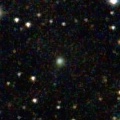
|
Now it is 15.6 mag (May 8, Sandor Szabo). In the Northern Hemisphere, it stays observable at 15-16 mag for a long time from spring to early 2022. In the Southern Hemisphere, it is not observable until the end of 2021.
Date(TT) R.A. (2000) Decl. Delta r Elong. m1 Best Time(A, h)
May 15 17 43.70 79 51.4 3.174 3.153 79 15.5 2:14 (180, 45)
May 22 16 17.20 80 31.6 3.163 3.133 79 15.4 0:22 (180, 45)
|

|
It has not been observed yet in this apparition. The condition of this apparition is bad. It brightens up to 15.5 mag in spring, however, it is not observable until autumn when it becomes fainter than 19 mag.
Date(TT) R.A. (2000) Decl. Delta r Elong. m1 Best Time(A, h)
May 15 3 16.54 19 48.6 2.235 1.226 2 15.6 3:18 (231,-16)
May 22 3 43.72 21 41.7 2.229 1.219 2 15.5 3:11 (229,-15)
|

|
Now it is 15.4 mag (Apr. 19, Toshihiko Ikemura, Hirohisa Sato). In the Northern Hemisphere, it stays observable for a long time while it is getting fainter slowly. In the Southern Hemisphere, it will never be observable again.
Date(TT) R.A. (2000) Decl. Delta r Elong. m1 Best Time(A, h)
May 15 14 16.10 67 50.8 5.746 5.875 92 15.6 22:41 (180, 57)
May 22 14 4.69 66 54.4 5.829 5.923 90 15.6 22:02 (180, 58)
|
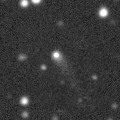
|
Now it is 16.0 mag (May 7, Sandor Szabo). It stays observable at 16 mag from 2021 to 2022. Toshihiko Ikemura and Hirohisa Sato reported it was very bright as 14.2 mag on Apr. 19.
Date(TT) R.A. (2000) Decl. Delta r Elong. m1 Best Time(A, h)
May 15 13 50.29 -9 10.1 3.897 4.830 154 15.7 22:17 ( 0, 46)
May 22 13 46.70 -7 41.4 3.941 4.818 146 15.7 21:46 ( 0, 47)
|

|
It had been observed as 8-9 mag for a long time in 2020. Now it is fading. It has already faded down to 16.4 mag (Mar. 27, Thomas Lehmann). It will be observable in good condition after this in the Southern Hemisphere. It locates extremely low after this in the Northern Hemisphere.
Date(TT) R.A. (2000) Decl. Delta r Elong. m1 Best Time(A, h)
May 15 17 18.45 -44 34.6 3.771 4.638 145 15.7 1:49 ( 0, 10)
May 22 17 10.71 -45 13.9 3.794 4.702 150 15.8 1:14 ( 0, 10)
|
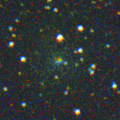
|
Now it is 15.8 mag (Jan. 16, Slooh.com Canary Islands Observatory). Appearing in the morning sky. In the Northern Hemisphere, it stays observable in good condition while the comet will be fading. In the Southern Hemipsphere, it stays locating extremely low after this.
Date(TT) R.A. (2000) Decl. Delta r Elong. m1 Best Time(A, h)
May 15 1 42.78 22 37.6 3.058 2.180 24 15.8 3:18 (244, 3)
May 22 1 57.29 24 23.6 3.045 2.196 27 15.9 3:11 (243, 5)
|
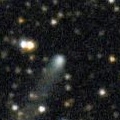
|
Now it is 15.7 mag (May 8, Sandor Szabo). It stays 15-16 mag until July. In the Northern Hemisphere, it stays observable in good condition for a long time. It is not observable after this in the Southern Hemisphere.
Date(TT) R.A. (2000) Decl. Delta r Elong. m1 Best Time(A, h)
May 15 18 52.65 51 43.5 4.996 5.207 96 15.8 3:18 (182, 73)
May 22 18 43.28 53 15.4 4.999 5.236 97 15.9 2:45 (180, 72)
|

|
Now it is 16.0 mag (Apr. 4, Michael Jager). Toshihiko Ikemura and Hirohisa Sato reported it was bright as 14.7 mag on Apr. 18. It is expected to brighten up to 13 mag in 2022. In the Southern Hemisphere, it stays observable in good condition for a long time. In the Northern Hemisphere, it stays observable until June, but it will not be observable at the high light.
Date(TT) R.A. (2000) Decl. Delta r Elong. m1 Best Time(A, h)
May 15 12 35.09 -20 42.1 4.028 4.843 139 15.9 21:01 ( 0, 34)
May 22 12 27.98 -20 35.6 4.063 4.797 131 15.9 20:42 ( 4, 34)
|
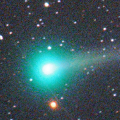
|
It brightened up to 5.6 mag in early December (Dec. 9, Marco Goiato). In mid December, it was visible at about 3 mag in the SOHO spacecraft images (Dec. 18, Hirohisa Sato). Appearing in the morning sky.
Date(TT) R.A. (2000) Decl. Delta r Elong. m1 Best Time(A, h)
May 15 0 2.24 14 45.9 3.359 2.802 49 16.1 3:18 (264, 18)
May 22 0 7.36 15 36.7 3.371 2.895 54 16.3 3:11 (265, 21)
|
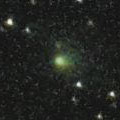
|
It brightened rapidly. Now it is bright as 15.8 mag (May 5, Katsumi Yoshimoto). It will be fading after this, and it will be fainter than 18 mag in July.
Date(TT) R.A. (2000) Decl. Delta r Elong. m1 Best Time(A, h)
May 15 12 46.68 5 31.5 1.582 2.394 133 16.3 21:12 ( 0, 60)
May 22 12 27.03 3 10.3 1.691 2.408 123 16.5 20:42 ( 8, 58)
|
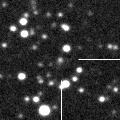
|
Now it is 16.3 mag (Apr. 19, Toshihiko Ikemura, Hirohisa Sato). It stays at 16-17 mag from 2020 to 2021. In the Northern Hemisphere, it stays observable in good condition for a long time. It locates extremely low in the Southern Hemisphere.
Date(TT) R.A. (2000) Decl. Delta r Elong. m1 Best Time(A, h)
May 15 19 41.31 45 50.1 8.708 8.828 93 16.3 3:18 (219, 75)
May 22 19 38.41 46 46.9 8.664 8.830 96 16.3 3:11 (203, 77)
|
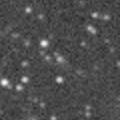
|
Now it is 16.6 mag (Apr. 21, Toshihiko Ikemura, Hirohisa Sato). It stays observable at 16.5-17 mag in good condition until October.
Date(TT) R.A. (2000) Decl. Delta r Elong. m1 Best Time(A, h)
May 15 17 19.92 -26 59.3 4.011 4.931 152 16.4 1:50 ( 0, 28)
May 22 17 14.82 -25 54.0 3.955 4.923 160 16.4 1:18 ( 0, 29)
|
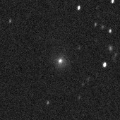
|
Now it is 16.4 mag (Apr. 24, ATLAS-MLO, Mauna Loa). It is observable at 16.5 mag from spring in 2020 to summer in 2021.
Date(TT) R.A. (2000) Decl. Delta r Elong. m1 Best Time(A, h)
May 15 16 53.40 -16 23.8 3.918 4.876 159 16.4 1:24 ( 0, 39)
May 22 16 43.12 -16 54.7 3.899 4.894 168 16.4 0:46 ( 0, 38)
|
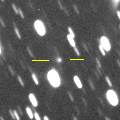
|
Now it is 16.5 mag (Apr. 20, Toshihiko Ikemura, Hirohisa Sato). It is observable at 16 mag from 2020 to 2021. In the Southern Hemisphere, it is not observable until summer.
Date(TT) R.A. (2000) Decl. Delta r Elong. m1 Best Time(A, h)
May 15 23 19.10 43 39.7 6.459 5.969 57 16.4 3:18 (238, 38)
May 22 23 19.61 43 56.5 6.399 5.973 60 16.4 3:11 (239, 42)
|
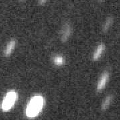
|
Now it is 16.2 mag (May 9, Toshihiko Ikemura, Hirohisa Sato). It is expected to brighten up to 11 mag in 2023. In the Northern Hemisphere, it stays observable in good condition for a long time. It locates extremely low in the Southern Hemisphere.
Date(TT) R.A. (2000) Decl. Delta r Elong. m1 Best Time(A, h)
May 15 18 4.13 49 28.1 6.485 6.790 103 16.5 2:34 (180, 76)
May 22 17 56.23 50 3.4 6.417 6.745 104 16.5 1:58 (180, 75)
|
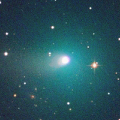
|
Brightened rapidly, and it brightened up to 9.7 mag in November (Nov. 15, Chris Wyatt). Now it is fading. It has already faded down to 15.9 mag (Apr. 30, Catalina Sky Survey). In the Northern Hemisphere, it stays observable in good condition for a long time. In the Southern Hemisphere, it locates extremely low after this.
Date(TT) R.A. (2000) Decl. Delta r Elong. m1 Best Time(A, h)
May 15 7 34.63 36 25.9 2.688 2.293 56 16.5 20:34 (113, 36)
May 22 7 50.38 35 30.0 2.801 2.343 53 16.8 20:42 (113, 32)
|
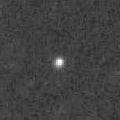
|
Now it is 16.7 mag (Apr. 27, ATLAS-HKO, Haleakala). It is expected to brighten up to 10 mag in 2023. In the Northern Hemisphere, it stays observable in good condition until 2023 autumn. In the Southern Hemipshere, it stays extremely low until mid July, then it becomes unobservable for a while. But it becomes observable in good condition after 2023 summer.
Date(TT) R.A. (2000) Decl. Delta r Elong. m1 Best Time(A, h)
May 15 12 15.51 39 1.7 6.932 7.290 106 16.8 20:42 (180, 86)
May 22 12 11.78 38 59.0 6.975 7.237 101 16.8 20:42 (124, 83)
|
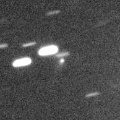
|
Now it is 16.7 mag (Apr. 19, Toshihiko Ikemura, Hirohisa Sato). It will approach to Earth down to 0.2 a.u. in December, and it is expected to brighten up to 4 mag. In the Northern Hemisphere, it stays observable in good condition for a long time until December while the comet is brightening gradually. In the Southern Hemisphere, it is not observable until mid December.
Date(TT) R.A. (2000) Decl. Delta r Elong. m1 Best Time(A, h)
May 15 11 3.68 59 53.7 3.598 3.654 85 16.9 20:34 (162, 63)
May 22 10 52.92 58 51.2 3.608 3.572 79 16.8 20:42 (151, 60)
|

|
Now it is 17.4 mag (Apr. 25, Telescope Live, El Sauce). It will brighten up to 9 mag, and will be observable in good condition in winter.
Date(TT) R.A. (2000) Decl. Delta r Elong. m1 Best Time(A, h)
May 15 23 4.33 -9 51.3 2.377 2.256 70 17.1 3:18 (294, 15)
May 22 23 16.45 -8 41.0 2.248 2.201 74 16.9 3:11 (294, 17)
|
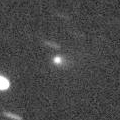
|
First return of a new periodic comet which brightened up to 16 mag in 2014. Now it is 17.0 mag (Apr. 27, Thomas Lehmann). It stays observable at 16-17 mag in good condition until July.
Date(TT) R.A. (2000) Decl. Delta r Elong. m1 Best Time(A, h)
May 15 12 8.65 7 15.0 1.460 2.198 124 17.0 20:36 ( 0, 62)
May 22 12 9.07 5 50.0 1.512 2.187 118 17.0 20:42 ( 17, 60)
|

|
Now it is 16.7 mag (Apr. 11, Toshihiko Ikemura, Hirohisa Sato). It will be fading slowly.
Date(TT) R.A. (2000) Decl. Delta r Elong. m1 Best Time(A, h)
May 15 18 2.69 -14 48.2 6.777 7.604 142 17.0 2:33 ( 0, 40)
May 22 17 57.57 -14 25.8 6.734 7.629 150 17.0 2:00 ( 0, 41)
|

|
Now it is 19.3 mag (Apr. 12, J. L. Virlichie, P. Traverse). It will brighten up to 15 mag from summer to autumn, and it will be observable in good condition.
Date(TT) R.A. (2000) Decl. Delta r Elong. m1 Best Time(A, h)
May 15 22 14.01 -7 22.3 2.379 2.441 81 17.1 3:18 (301, 26)
May 22 22 23.66 -6 47.4 2.282 2.425 85 17.0 3:11 (302, 28)
|
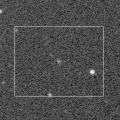
|
It will brighten up to 12.5 mag in 2022 summer. In the Southern Hemisphere, it stays observable in excellent condition for a long time. In the Northern Hemisphere, it is not observable until August in 2022.
Date(TT) R.A. (2000) Decl. Delta r Elong. m1 Best Time(A, h)
May 15 3 13.80 -42 4.2 5.851 5.432 60 17.2 3:18 (296,-48)
May 22 3 18.25 -42 21.7 5.762 5.383 63 17.1 3:11 (297,-45)
|
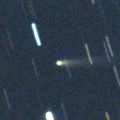
|
First return of a new periodic comet which brightened up to 14-15 mag in 2006. It brightened up to 14.5 mag in March (Mar. 16, F. Kugel, J.-G. Bosch). Now it is fading. It has already faded down to 16.7 mag (Apr. 27, Thomas Lehmann). It will be fainter than 18 mag in June.
Date(TT) R.A. (2000) Decl. Delta r Elong. m1 Best Time(A, h)
May 15 13 18.28 20 2.7 1.295 2.093 129 17.1 21:45 ( 0, 75)
May 22 13 20.70 18 59.3 1.380 2.133 125 17.4 21:20 ( 0, 74)
|

|
It has not been observed yet in this apparition. It will brighten up to 15 mag from summer to autumn. In the Southern Hemisphere, it stays observable for a long time. In the Northern Hemisphere, it is not observable until late June. But it will be observable in good condition after that.
Date(TT) R.A. (2000) Decl. Delta r Elong. m1 Best Time(A, h)
May 15 1 2.23 -7 24.2 2.408 1.826 44 17.5 3:18 (274, -7)
May 22 1 19.06 -5 19.0 2.336 1.788 46 17.2 3:11 (273, -5)
|
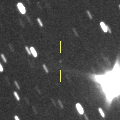
|
Now it is 18.5 mag (May 9, Toshihiko Ikemura, Hirohisa Sato). It will brighten very rapidly, and it will be observable at 10 mag in good condition from October to December. In the Northern Hemisphere, it locates somewhat low at the high light.
Date(TT) R.A. (2000) Decl. Delta r Elong. m1 Best Time(A, h)
May 15 16 48.40 15 28.2 1.037 1.926 140 17.5 1:19 ( 0, 70)
May 22 16 44.40 16 36.0 0.979 1.877 141 17.3 0:47 ( 0, 72)
|
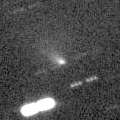
|
Now it is 17.0 mag (Apr. 14, Thomas Lehmann). It will be fading after this. In the Northern Hemisphere, it will be too low to observe in May. In the Southern Hemisphere, it stays observable in good condition after this.
Date(TT) R.A. (2000) Decl. Delta r Elong. m1 Best Time(A, h)
May 15 7 36.95 -1 13.8 1.772 1.619 64 17.3 20:34 ( 75, 18)
May 22 7 57.44 -3 0.9 1.857 1.678 63 17.5 20:42 ( 76, 14)
|

|
Now it is 18.4 mag (May 9, Toshihiko Ikemura, Hirohisa Sato). It will brighten up to 15.5 mag from summer to autumn. It stays observable for a long time.
Date(TT) R.A. (2000) Decl. Delta r Elong. m1 Best Time(A, h)
May 15 15 31.61 -15 12.5 1.191 2.201 176 17.6 0:02 ( 0, 40)
May 22 15 25.66 -14 39.1 1.160 2.166 171 17.4 23:24 ( 0, 40)
|
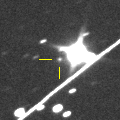
|
Now it is 17.0 mag (Apr. 30, ATLAS-HKO, Haleakala). It stays observable at 17-18 mag for a long time until 2024.
Date(TT) R.A. (2000) Decl. Delta r Elong. m1 Best Time(A, h)
May 15 14 55.39 -8 19.8 8.169 9.157 167 17.5 23:22 ( 0, 47)
May 22 14 50.89 -7 54.9 8.188 9.146 160 17.5 22:50 ( 0, 47)
|

|
Now it is 17.0 mag (Apr. 22, ATLAS-HKO, Haleakala). It brightened rapidly. It stays 17-18 mag for a long time from 2021 to 2022. In the Southern Hemisphere, it stays observable in good condition for a long time. In the Northern Hemisphere, it is observable only until May.
Date(TT) R.A. (2000) Decl. Delta r Elong. m1 Best Time(A, h)
May 15 8 15.74 -7 46.4 5.659 5.502 75 17.6 20:34 ( 64, 21)
May 22 8 16.47 -8 1.0 5.748 5.489 70 17.6 20:42 ( 69, 14)
|
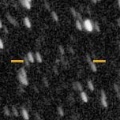
|
Now it is 17.5 mag (Apr. 24, Ken-ichi Kadota). It will brighten up to 15.5 mag in winter. In the Northern Hemisphere, it stays observable in good condition for a long time. It is not observable at all in the Southern Hemisphere.
Date(TT) R.A. (2000) Decl. Delta r Elong. m1 Best Time(A, h)
May 15 21 12.05 51 23.9 4.009 3.919 77 17.6 3:18 (226, 60)
May 22 21 11.40 54 3.5 3.926 3.877 79 17.6 3:11 (219, 61)
|

|
First return of a new periodic comet observed at 17 mag in 2014. It has not been observed yet in this apparition. It is expected to brighten up to 17 mag from summer to autumn, and it will be observable in good condition.
Date(TT) R.A. (2000) Decl. Delta r Elong. m1 Best Time(A, h)
May 15 23 15.75 -2 14.5 1.866 1.708 65 17.7 3:18 (286, 18)
May 22 23 32.10 0 6.6 1.808 1.697 67 17.6 3:11 (284, 20)
|
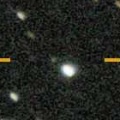
|
Now it is 17.2 mag (Apr. 28, ATLAS-HKO, Haleakala). It is expected to brighten up to 12 mag in 2023. In the Northern Hemisphere, it is observable in good condition in 2021. But it is observable only until November in 2022. In the Southern Hemisphere, it locates extremely low in 2021. But it will be observable in good condition at the high light.
Date(TT) R.A. (2000) Decl. Delta r Elong. m1 Best Time(A, h)
May 15 18 38.78 45 58.0 6.789 7.069 102 17.7 3:08 (180, 79)
May 22 18 34.58 46 15.7 6.703 7.021 104 17.6 2:37 (180, 79)
|
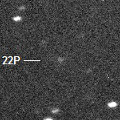
|
Now it is 17.4 mag (Apr. 19, ATLAS-HKO, Haleakala). It will be observable at 11 mag from winter to spring in 2022. In 2021, it is observable until July or August when it brightens up to 16-17 mag.
Date(TT) R.A. (2000) Decl. Delta r Elong. m1 Best Time(A, h)
May 15 10 20.95 14 37.6 2.752 3.055 97 17.7 20:34 ( 56, 59)
May 22 10 23.52 14 18.4 2.812 3.015 91 17.6 20:42 ( 65, 52)
|
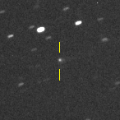
|
Now it is 17.6 mag (Apr. 11, Toshihiko Ikemura, Hirohisa Sato). It will brighten up to 16 mag in 2022. In 2021, it stays observable at 18 mag until September.
Date(TT) R.A. (2000) Decl. Delta r Elong. m1 Best Time(A, h)
May 15 13 24.68 3 58.1 2.497 3.354 142 17.7 21:51 ( 0, 59)
May 22 13 22.05 3 48.6 2.543 3.341 135 17.6 21:21 ( 0, 59)
|
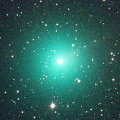
|
It brightened up to 7.3 mag in November (Nov. 7, Marco Goiato). Now it is fading. It has already faded down to 17.3 mag (Apr. 23, Thomas Lehmann). In the Northern Hemisphere, it stays observable in excellent condition for a long time. In the Southern Hemisphere, it stays locating extremely low after this.
Date(TT) R.A. (2000) Decl. Delta r Elong. m1 Best Time(A, h)
May 15 8 22.02 39 50.6 3.218 2.952 65 17.7 20:34 (113, 46)
May 22 8 33.36 38 59.6 3.367 3.024 61 17.9 20:42 (114, 41)
|

|
Peculiar asteroid moving along a cometary orbit. The condition is bad in this apparition. It brightened up to 17 mag in winter, but it was not observable. Appearing in the morning sky. But it will be fainter than 18 mag soon.
Date(TT) R.A. (2000) Decl. Delta r Elong. m1 Best Time(A, h)
May 15 0 57.25 6 40.6 2.391 1.717 38 17.7 3:18 (263, 2)
May 22 1 13.12 7 50.0 2.400 1.766 41 17.8 3:11 (263, 4)
|
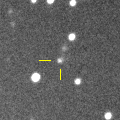
|
Now it is 17.5 mag (Apr. 18, Toshihiko Ikemura, Hirohisa Sato). Fading slowly. In 2021, it stays observable at 17-18 mag in good condition until early summer.
Date(TT) R.A. (2000) Decl. Delta r Elong. m1 Best Time(A, h)
May 15 12 55.84 -14 8.8 6.196 7.035 143 17.7 21:23 ( 0, 41)
May 22 12 55.08 -13 37.2 6.281 7.051 136 17.8 20:54 ( 0, 41)
|
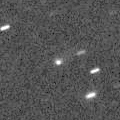
|
Now it is 17.1 mag (Apr. 18, Toshihiko Ikemura, Hirohisa Sato). It stays 17-18 mag for a long time from 2021 to 2023.
Date(TT) R.A. (2000) Decl. Delta r Elong. m1 Best Time(A, h)
May 15 10 37.90 11 51.0 4.549 4.869 102 17.7 20:34 ( 47, 59)
May 22 10 39.44 11 34.7 4.648 4.862 96 17.8 20:42 ( 57, 53)
|
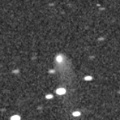
|
It brightened up to 13.8 mag in autumn in 2019 (Sept. 3, 2019, Chris Wyatt). Now it is fading slowly. It stays 18 mag until autumn.
Date(TT) R.A. (2000) Decl. Delta r Elong. m1 Best Time(A, h)
May 15 0 39.76 15 24.8 8.479 7.732 39 17.8 3:18 (258, 11)
May 22 0 42.11 16 1.3 8.447 7.775 45 17.8 3:11 (260, 14)
|
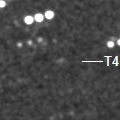
|
In the Northern Hemisphere, it is observable at 17-18 mag from spring to autumn. It is not observable in the Southern Hemisphere.
Date(TT) R.A. (2000) Decl. Delta r Elong. m1 Best Time(A, h)
May 15 2 35.34 58 33.3 2.937 2.271 40 17.9 3:18 (209, 17)
May 22 2 49.32 61 22.4 2.889 2.251 42 17.8 3:11 (207, 20)
|
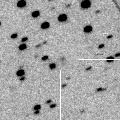
|
Now it is 18.2 mag (Apr. 19, Toshihiko Ikemura, Hirohisa Sato). In the Northern Hemisphere, it stays observable at 18 mag for a long time from 2021 to 2022. It is not observable in the Southern Hemisphere.
Date(TT) R.A. (2000) Decl. Delta r Elong. m1 Best Time(A, h)
May 15 17 41.10 54 20.6 6.812 7.082 101 17.9 2:11 (180, 71)
May 22 17 31.79 55 5.2 6.806 7.082 101 17.9 1:34 (180, 70)
|
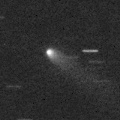
|
Now it is 18.6 mag (Apr. 4, Michael Jager). Although it is around the aphelion, it is much brighter than originally predicted.
Date(TT) R.A. (2000) Decl. Delta r Elong. m1 Best Time(A, h)
May 15 10 42.38 10 24.3 5.087 5.422 104 18.5 20:34 ( 43, 59)
May 22 10 42.90 10 11.6 5.198 5.424 97 18.6 20:42 ( 55, 53)
|
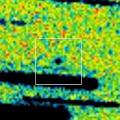
|
It was expected to brighten up to 13 mag from spring to summer. But actually, it is extremely faint as 19.0 mag (Mar. 22, A. C. Gilmore, P. M. Kilmartin). In the Southern Hemisphere, it stays observable in good condition for a long time. In the Northern Hemisphere, it is not observable until late August.
Date(TT) R.A. (2000) Decl. Delta r Elong. m1 Best Time(A, h)
May 15 1 14.18 -46 10.6 1.556 1.564 71 18.5 3:18 (308,-28)
May 22 1 57.15 -45 11.8 1.552 1.549 70 18.6 3:11 (306,-32)
|
|
![]()
 C/2019 N1 ( ATLAS )
C/2019 N1 ( ATLAS ) C/2019 F1 ( ATLAS-Africano )
C/2019 F1 ( ATLAS-Africano ) C/2019 T2 ( Lemmon )
C/2019 T2 ( Lemmon ) C/2018 U1 ( Lemmon )
C/2018 U1 ( Lemmon ) C/2020 F5 ( MASTER )
C/2020 F5 ( MASTER ) 8P/Tuttle
8P/Tuttle C/2021 A7 ( NEOWISE )
C/2021 A7 ( NEOWISE ) 117P/Helin-Roman-Alu 1
117P/Helin-Roman-Alu 1 C/2020 M5 ( ATLAS )
C/2020 M5 ( ATLAS ) 201P/LONEOS
201P/LONEOS C/2018 N2 ( ASASSN )
C/2018 N2 ( ASASSN ) C/2020 H6 ( ATLAS )
C/2020 H6 ( ATLAS ) C/2017 T2 ( PanSTARRS )
C/2017 T2 ( PanSTARRS ) 17P/Holmes
17P/Holmes C/2019 K7 ( Smith )
C/2019 K7 ( Smith ) C/2020 Y2 ( ATLAS )
C/2020 Y2 ( ATLAS ) C/2020 S3 ( Erasmus )
C/2020 S3 ( Erasmus ) C/2020 S8 ( Lemmon )
C/2020 S8 ( Lemmon ) C/2019 O3 ( Palomar )
C/2019 O3 ( Palomar ) C/2020 O2 ( Amaral )
C/2020 O2 ( Amaral ) C/2017 Y2 ( PanSTARRS )
C/2017 Y2 ( PanSTARRS ) C/2019 T3 ( ATLAS )
C/2019 T3 ( ATLAS ) C/2019 U5 ( PanSTARRS )
C/2019 U5 ( PanSTARRS ) 156P/Russell-LINEAR
156P/Russell-LINEAR C/2020 V2 ( ZTF )
C/2020 V2 ( ZTF ) C/2021 A1 ( Leonard )
C/2021 A1 ( Leonard ) 67P/Churyumov-Gerasimenko
67P/Churyumov-Gerasimenko 413P/2020 W4 ( Larson )
413P/2020 W4 ( Larson ) C/2017 U7 ( PanSTARRS )
C/2017 U7 ( PanSTARRS ) 284P/McNaught
284P/McNaught C/2020 R7 ( ATLAS )
C/2020 R7 ( ATLAS ) 409P/2020 V1 ( LONEOS-Hill )
409P/2020 V1 ( LONEOS-Hill ) 106P/Schuster
106P/Schuster 6P/d'Arrest
6P/d'Arrest C/2020 N1 ( PanSTARRS )
C/2020 N1 ( PanSTARRS ) 57P/du Toit-Neujmin-Delporte
57P/du Toit-Neujmin-Delporte C/2020 F2 ( ATLAS )
C/2020 F2 ( ATLAS ) C/2020 F7 ( Lemmon )
C/2020 F7 ( Lemmon ) C/2021 D2 ( ZTF )
C/2021 D2 ( ZTF ) P/2014 W12 ( Gibbs )
P/2014 W12 ( Gibbs ) C/2020 K1 ( PanSTARRS )
C/2020 K1 ( PanSTARRS ) 22P/Kopff
22P/Kopff 152P/Helin-Lawrence
152P/Helin-Lawrence C/2020 M3 ( ATLAS )
C/2020 M3 ( ATLAS ) (301964) 2000 EJ37
(301964) 2000 EJ37 C/2019 C1 ( ATLAS )
C/2019 C1 ( ATLAS ) 99P/Kowal 1
99P/Kowal 1 C/2017 B3 ( LINEAR )
C/2017 B3 ( LINEAR ) C/2020 T4 ( PanSTARRS )
C/2020 T4 ( PanSTARRS ) C/2016 Q2 ( PanSTARRS )
C/2016 Q2 ( PanSTARRS ) 47P/Ashbrook-Jackson
47P/Ashbrook-Jackson C/2020 K5 ( PanSTARRS )
C/2020 K5 ( PanSTARRS )![]()
























































